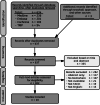Transfusion-associated circulatory overload-a systematic review of diagnostic biomarkers
- PMID: 30488959
- PMCID: PMC7379706
- DOI: 10.1111/trf.15068
Transfusion-associated circulatory overload-a systematic review of diagnostic biomarkers
Abstract
Background: Transfusion-associated circulatory overload (TACO) is the leading cause of transfusion-related major morbidity and mortality. Diagnosing TACO is difficult because there are no pathognomonic signs and symptoms. TACO biomarkers may aid in diagnosis, decrease time to treatment, and differentiate from other causes of posttransfusion dyspnea such a transfusion-related acute lung injury.
Study design and methods: A systematic review of literature was performed in EMBASE, PubMed, the TRIP Database, and the Cochrane Library, from inception to June 2018. All articles discussing diagnostic markers for TACO were included. Non-English articles or conference abstracts were excluded.
Results: Twenty articles discussing biomarkers for TACO were included. The majority investigated B-type natriuretic peptide (BNP) and the N-terminal prohormone cleavage fragment of BNP (NT-proBNP), markers of hydrostatic pressure that can be determined within 1 hour. The data indicate that a post/pretransfusion NT-proBNP ratio > 1.5 can aid in the diagnosis of TACO. Posttransfusion levels of BNP less than 300 or NT-proBNP less than 2000 pg/mL, drawn within 24 hours of the reaction, make TACO unlikely. Cut-off levels that exclude TACO are currently unclear. In critically ill patients, the specificity of natriuretic peptides for circulatory overload is poor. Other biomarkers, such as cytokine profiles, cannot discriminate between TACO and transfusion-related acute lung injury.
Conclusion: Currently, BNP and NT-proBNP are the primary diagnostic biomarkers researched for TACO. An NT-proBNP ratio greater than 1.5 is supportive of TACO, and low levels of BNP or NT-proBNP can exclude TACO. However, they are unreliable in critically ill patients. Other biomarkers, including cytokines and pulmonary edema fluid-to-serum protein ratio have not yet been sufficiently investigated for clinical use.
© 2018 The Authors. Transfusion published by Wiley Periodicals, Inc. on behalf of AABB.
Conflict of interest statement
The authors have disclosed no conflicts of interest.
Figures


References
-
- Andrzejewski C, Casey MA, Popovsky MA. How we view and approach transfusion‐associated circulatory overload: pathogenesis, diagnosis, management, mitigation, and prevention. Transfusion 2013;53:3037‐47. - PubMed
-
- Bolton‐Maggs, PH , Thomas D, Watt A. Annual SHOT report 2016. [cited 2017 Nov]. Available from: https://www.shotuk.org/wp-content/uploads/myimages/SHOT-Report-2016_web_....
-
- Transfusie‐ en Transplantatiereacties in Patienten . TRIP rapport hemovigilantie 2015. [cited 2017 Nov]. Available from: https://www.tripnet.nl/wp-content/uploads/2017/12/Trip.HEMO‐uitgebreid‐def‐met‐links.3.pdf.
-
- Agence Nationale de Sécurité du Médicament et des Produits de Santé . Rapport dactivité hémovigilance 2015. [cited 2017 Nov]. Available from: http://ansm.sante.fr/var/ansm_site/storage/original/application/27ce3d07....
-
- National Healthcare Safety Network—Centre for Communicable Diseases and Infection Control . Transfusion transmitted injuries surveillance system (TTISS): 2009‐2013 Summary Results. [cited 2018 Aug]. Available from: https://www.canada.ca/content/dam/hc-sc/healthy-canadians/migration/publ....
Publication types
MeSH terms
Substances
LinkOut - more resources
Full Text Sources
Medical
Research Materials

